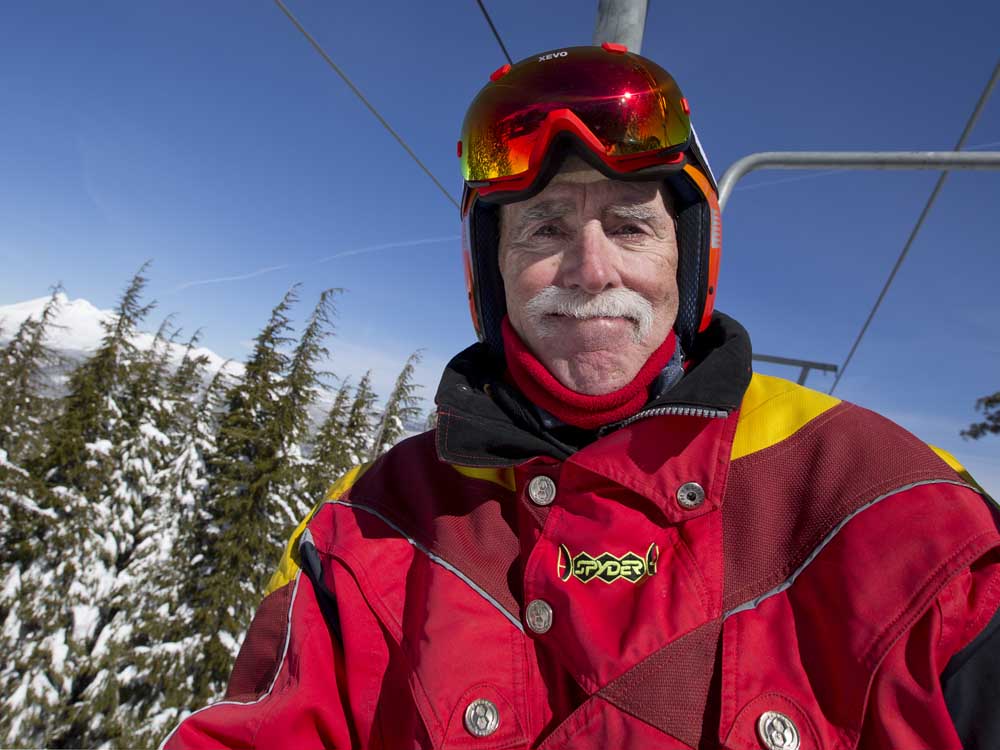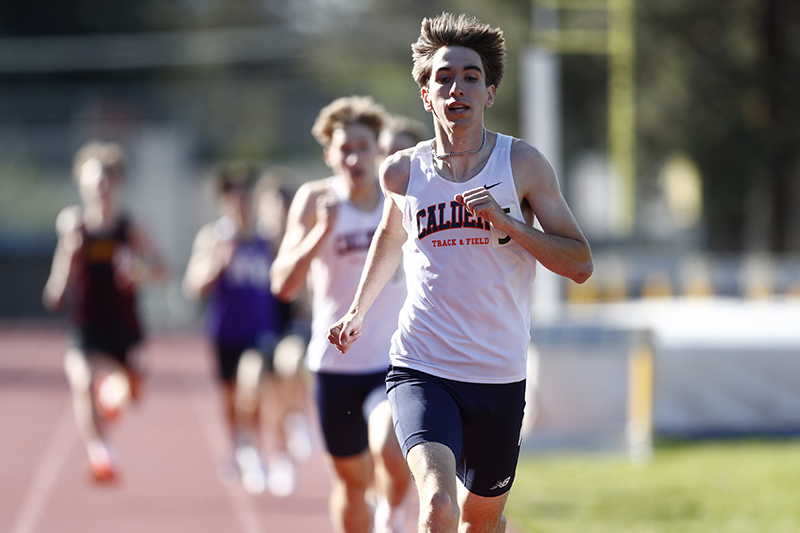How old is too old for downhill skiing?
Published 3:47 pm Wednesday, March 15, 2017

- Downhill skier Larry Barker rides the Sunrise Chairlift at Mount Bachelor on March 1, 2017. (Andy Tullis/Bulletin photo)
Where Larry Barker likes to ski — in the powder, far from the smooth, groomed runs most people prefer — he jokes that the trees jump in front of him.
“It’s like an obstacle course,” he said.
The 78-year-old longtime Bend resident said he knows it’s risky. He’s not immune to the hazards of downhill skiing, a sport he’s practiced regularly since 1973. He’s broken ribs, torn meniscuses, hurt his shoulder and his back.
“It’s a tough sport,” he said. “Somebody could hit you. You could fall down. I don’t think about it because it would cripple my skiing. I just have fun.”
Some research extols the health benefits of downhill skiing. Studies have found the sport improves strength, oxygen intake, blood pressure, balance and blood sugar control. But doctors warn it’s not a sport the over 60 crowd should take lightly. Proper preparation, including exercise and an instructor, is key.
Skiing also makes people feel good, a factor that John Seifert, an associate professor of health and human performance at Montana State University, said cannot be discounted. Seifert took an audience through the available skiing research on a recent weekend during a presentation in Bend for the American College of Sports Medicine. Research on the subject to date overwhelmingly features aging adults — likely a factor of having more time to participate in studies — so Seifert said his talk would focus on that population.
Older adults are especially prone to cutting out physical activity during the cold winter months, when even going outside for a walk can be hazardous, Seifert said during his talk. That can make loneliness and depression worse.
Seifert, admitting he’s biased on the issue, asked the audience, “Why not ski?”
The research
A group of Austrian researchers looked into how downhill skiing stacked up as exercise for a 2011 study in the Journal of Sports Science and Medicine. They followed a group of skiers whose average age was 61 as they hit the slopes for a 75-minute session in a Salzburg ski resort. Among other findings, they noted that the subjects’ heart rates fell within the ACSM’s recommended range for maintaining fitness.
“What it tells me is you don’t have to be an expert level skier to go out and ski,” Seifert said. “That all skiers could maintain a high enough heart rate to induce some level of training.”
For the Salzburg Skiing for the Elderly Study, also out of Austria, researchers measured subjects’ aerobic capacity, leg strength and balance before and after skiing for 12 weeks. The study included 47 people between the ages of 60 and 76 who were divided into either a ski group or a control group.
The maximum amount of oxygen used during exercise, a factor used to determine athletic capacity, improved by an average of 7.2 percent after 12 weeks among the ski group, compared with no change in the control group. Skiers were able to jump an average of 6 percent higher at the end, while the control group’s jump height decreased by an average of nearly 12 percent. Strength in both legs increased by 16 percent among the skiers, compared with 7 percent among the control group. The study didn’t find significant changes in balance.
There are two types of muscle contractions: those that happen when muscles are doing work and when they’re resisting work. Downhill skiing results in the latter, which makes it great for building muscle mass, said Timothy Burnett, a kinesiology instructor at Oregon State University-Cascades. Building muscle mass is especially important for people in their 70s and 80s, when muscle loss accelerates.
That said, downhill skiing isn’t going to work the heart quite as much as, say, cross-country skiing, which is among the best sports for cardiorespiratory fitness, Burnett said. Some world records for highest oxygen intakes during exercise are held by cross-country skiers.
For that reason, Burnett said it would be a good idea for older adults to engage in another form of exercise in addition to cross-country skiing if they want to be more fit. But the most important part of exercise is finding something you like enough to stick with.
“For decades and decades and decades we have known that exercise is good for you,” he said. “We know it’s good, but getting people to do it is difficult.”
Easy rider
Despite research showing downhill skiing can be good exercise, Seifert said it can be hard to convince older adults that it doesn’t have to be an extreme sport.
“This isn’t some 25-year-old pin binding, 110 millimeter-wide-ski kind of guy hocking off a 30-foot rock,” he said. “That’s not skiing. It’s cool to watch, but it’s not skiing.”
Unlike Barker, John Stockham describes himself as an “easy rider” when it comes to downhill skiing.
“I’m not a daredevil,” said the 70-year-old Bend resident, who estimates he skis at Mount Bachelor 50 to 60 days each year.
Being retired allows him to buy a pass for unlimited skiing each season and then pick and choose which days he goes up. If it’s too cloudy, cold or windy, “I blow it off,” he said. If it’s a nice day, you can count on him being at the mountain.
Stockham didn’t start skiing regularly until he moved from Wisconsin to Bend at age 64. When he was 39, he underwent quadruple bypass surgery because of severe blockage in the arteries around his heart, mostly a result of bad genes. Since then, there’s been no other health issues. He’s a self-described “health nut,” and he feels skiing is helping him stay not only physically fit, but happy as well.
“I feel young,” he said. “When you’re skiing downhill, you’re happy, you feel good, you feel very fortunate to be out there every day. I think there is a certain level pride: I’m still in the game.”
Cross-country vs. downhill
These days, John Mowat has taken to cross-county skiing. He used to downhill ski regularly, but has found that at 87, it’s become more demanding. He no longer likes going as fast as he used to.
The Bend resident estimates he and his wife get out two to three times per week.
“I don’t even do it particularly for the health benefits,” he said. “Well, that’s sort of in the back of my mind, but I do it because I love it.”
Dr. Timothy Bollom, an orthopedic surgeon with The Center Orthopedic & Neurosurgical Care & Research in Bend, said while he said there are multiple benefits to downhill skiing — it helps maintain bone mass and improves strength and balance — it’s a risky sport.
He would know. He’s the one who repairs people’s knees when they get injured. Downhill skiing injuries are the most common reason Bollom reconstructs anterior cruciate ligaments, or ACLs — the ones that run across the middle of the knee — among his patients over 50.
“What I tell my folks is, ‘Look, if you’re new to the sport or even if you’re not, we see a much higher rate of injuries based on visibility and snow conditions,’” he said.
On icy days, people tend to fracture their shoulders or the place where their shin meets their knees, Bollom said. When there’s bad visibility, people tend to tear ligaments in their lower extremities, like the ACL.
If people over 60 are going to take up downhill skiing, Bollom recommends preseason conditioning. Strengthen your hamstrings, quadriceps and abdominal muscles. He also encourages people to take lessons.
“There’s nothing that says they can’t do it,” he said.
Bollom generally recommends cross-country skiing over downhill to his older patients, especially if they have arthritis.
Some research has shown cross-country delivers a bigger fitness benefit. A 2016 study that compared downhill skiing, cross-county skiing and stationary cycling found that one would have to downhill ski for about two and a half hours to burn the same number of calories as they would during one hour of cross-county skiing or cycling. Maximum oxygen consumption was also higher among the latter two sports.
“If you can go out and cross country ski, which is one of the most beneficial things you can do for cardiorespirartory fitness, awesome,” Burnett said.
Barker echoed Bollom’s point about taking lessons before downhill skiing. Otherwise, he said, you’ll learn other people’s bad habits, and those are tough to get rid of. He also advises people to watch their surroundings on the hill. And he stays home when it’s windy or raining.
Aside from those things, he thinks aging shouldn’t be about mourning the long-gone body or abilities you had 20 years ago. He lives life to the fullest: He’s in good shape, he has a good sense of humor (loves puns) and reads a book a week.
When it comes to skiing — as with everything in life — he says people should be able to do what they want to do.
“You never know what’s going to happen tomorrow,” he said. “I think you should live for today.”
— Reporter: 541-383-0304,
tbannow@bendbulletin.com
“It’s a tough sport. Somebody could hit you. You could fall down. I don’t think about it because it would cripple my skiing. I just have fun.”— Larry Barker, skier since 1973
Bend Ski Club
Lots of older skiers, including some of those interviewed for this article, are members of the Bend Ski Club. For information on the club, including how to join, visit bendskiclub.net.






